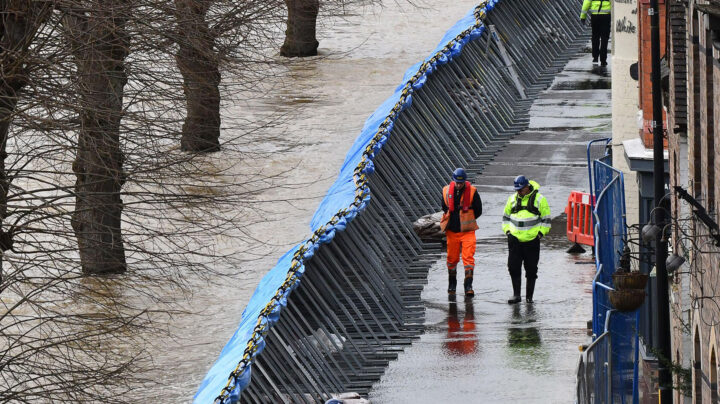Understanding Different Types of Floods Affecting the UK
The United Kingdom is no stranger to climate disasters, especially flooding which is entrenched in the history of the UK. There's a misunderstanding that flooding occurs only in coastal and river regions but this couldn't be further from the truth, as we saw in England and Wales in 2022 for example.

Today's urban landscape is just as important when considering the risks of floods, due to modern building methods and the ways in which water flows into drainage systems. This not only impacts businesses and government organizations but ordinary citizens as well - who often bear the brunt of a climate disaster.
With this in mind, we'd like to explore the different types of floods common in the UK with the hopes that it can help you better understand and prepare when you need to. Discover when where and how flooding occurs and how this impacts citizens, organisations and businesses in the UK.
Flood types in the United Kingdom - More than just excessive rainfall
If we break these types of floods down into categories, we get a better idea of when and why flood waters rise and how they impact different areas in the United Kingdom.
Aquatic landscape: Coastal flooding, flash floods and river floods
Coastal flooding
A coastal flood is as the name implies, happening along the shorelines of the United Kingdom. However, the interesting thing about coastal flooding is that it's a symptom of other weather events. While it's true that sea-water levels are rising here, as they are globally, most coastal floods are a result of a storm surge, excessive rainfall (sustained or sudden) and even tropical cyclones from other locations causing storm tides.
Coastal flooding usually rises along the banks of the shoreline and can also affect connected rivers which run through cities and nature reserves. Repeated flooding can start to erode manmade shorelines and compromise local infrastructure - reshaping coastlines and changing natural and manmade environments.
River flooding
Flood forecasting is a critical element in predicting coastal floods but even with accurate weather analysis, they can come on suddenly. Similarly, river flooding occurs along the banks of existing streams and even Oxbow Lakes and can have devastating effects on communities.
However, it is typically caused by manual issues (flood gates bursting along with a sudden release of water), heavy winter rainfall that meets obstructions or decreased capacity due to groundwater flooding. A river flood occurs along the banks but can often extend into towns and cities depending on the level of water and the width and height of its flow.
While the government does have flood risk management tactics in place to address these, community members should also take precautions in areas prone to flash flooding or major rainfall, especially in vallets.
Flash flooding
Earlier we spoke about how storm surges caused emergencies along many of Britain's coastlines but they are not the only symptom of climate change and major flood events. A flash flood can be just as devastating and sudden. Flash floods happen quick and are usually caused by heavy rainfall which means most people don't have time to prepare for them.
These are especially dangerous in low-lying areas and along already compromised grounds as they can create intense pressure on building infrastructure and wipe out agricultural and farming areas without warning.
We've already seen flash floods in Cheshire, North Yorkshire and in the heart of London where some regions have seen a month's worth of rainfall in a mere 24 hours.
Urban flooding, pluvial floods and overland flow from an overloaded drainage system
As the world's population has steadily taken over, so industrialisation and the rapid expansion of cities has impacted natural drainage and irrigation. Before the onslaught of asphalt and cement, water could effectively follow a lifecycle and evaporate or condescate into the air.
Now urban flooding is more common as a direct result of the methods humanity has used to build on top of naturally porous ground.
Pluvial flooding and overland flow
As more ground is covered and cities grow (while their drainage systems remain the same), so flooding becomes more common because water and intense rainfall has nowhere to go. Water then runs over the land taking out everything in its path, and this is when "overland flow" occurs. This is where pluvial flooding happens urban systems are destroyed.
Homes and businesses need to be protected from this with measures to prevent urban flooding and spaces for water to naturally infiltrate the ground and rise. However, many urban areas have to resort to other preventative climate change measures and profit sometimes overshadows environmental needs.
Heavy rainfall, melting snow and changing landscapes are putting the UK at greater risk
Most of the flood types we've covered today are the direct result of climate change, and human behaviour. Regardless of whether you live in coastal areas, rural regions or some of the biggest cities in the UK, flooding and disastrous weather events will affect you at some point in your life. In fact heavy rainfall and flooding is statistically on the rise with GreenMatch reporting that "By 2070, rainfall intensity could increase by up to 20% in summer and 25% in winter".
Aside from climate initiatives, it's important for communities to prioritise preparation with accessible solutions that benefit everybody and help protect from significant structural damage and the loss of human life.
We can help protect you when a flood occurs
While prevention is better than cure, most citizens, businesses and organisations can't escape the effects of climate change and need to be prepared for the changing tides. Over time, flash floods will become a common occurrence and the effects of overflow and urbanisation will become clearer.
With Geodesign Barriers, you can protect your home and business sites in urban and rural areas and save yourself the costs and losses associated with flooding and severe weather damage. Get in touch with us to find out which barrier solution is best for you and the area where you live or work.






